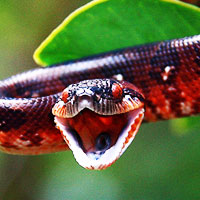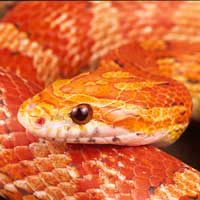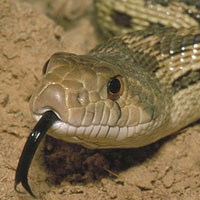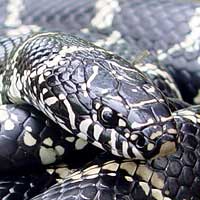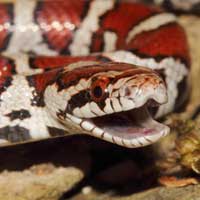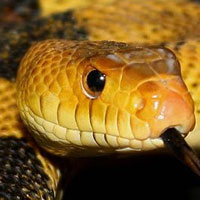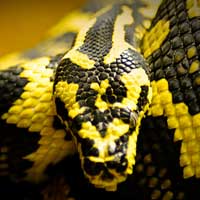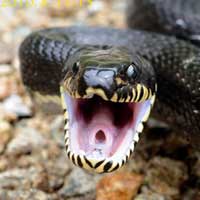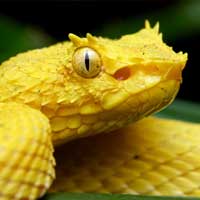Exploring the Unique and Captivating Black-headed Python
The scientific name of the Black-headed Python is Aspidites melanocephalus. It belongs to the snake family Pythonidae, which includes non-venomous constricting snakes commonly referred to as pythons.
Scientific Name: Aspidites melanocephalus
Snake Family: Pythonidae
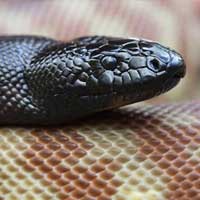
Introduction to the Black-headed Python
The Black-headed Python (Aspidites melanocephalus) is a non-venomous snake native to northern Australia. Its striking black head and banded body make it a standout species among python enthusiasts. Known for its manageable size and docile temperament, the Black-headed Python is a favorite among reptile keepers. This guide explores its natural habitat, diet, behavior, and care to help you understand and appreciate this remarkable species.
Where Does the Black-headed Python Live?
Black-headed Pythons are found across northern Australia, inhabiting a range of environments from coastal regions to arid zones. Their adaptability allows them to thrive in various habitats.
- Preferred Environments: Rocky outcrops, woodlands, and grasslands.
- Geographic Range: Northern Western Australia, Northern Territory, and Queensland.
- Shelter: Often found in burrows or under rocks to escape extreme temperatures.
| Region | Habitat Type | Key Features |
|---|---|---|
| Western Australia | Arid zones | Rocky terrain, sparse vegetation |
| Northern Territory | Woodlands | Moderate humidity, scattered trees |
| Queensland | Coastal areas | High humidity, dense vegetation |
What Does the Black-headed Python Eat?
The Black-headed Python is a carnivorous snake with a diet primarily consisting of reptiles. It has unique dietary preferences that set it apart from other pythons.
- Primary Diet: Lizards, snakes, and occasionally small mammals.
- Feeding Frequency:
- Juveniles: Every 5-7 days.
- Adults: Every 10-14 days.
- Hunting Behavior: Active hunter, using its black head to thermoregulate while stalking prey.
In captivity, a diet of pre-killed or thawed rodents and occasional reptiles is recommended to mimic natural feeding habits.
Behavior and Temperament of the Black-headed Python
The Black-headed Python is generally docile and curious, making it an excellent choice for reptile enthusiasts. However, its behavior varies depending on environmental factors and individual temperament.
- Activity Patterns: Crepuscular, most active during dawn and dusk.
- Defensive Behavior: Rarely aggressive but may hiss or strike when stressed.
- Interaction with Humans: Tolerates handling well if acclimated properly.
With regular interaction and proper care, Black-headed Pythons can develop a calm and manageable demeanor.
Health and Lifespan of the Black-headed Python
With the right care, Black-headed Pythons can live up to 25 years or more in captivity. Maintaining their health requires attention to environmental conditions and regular monitoring.
- Common Health Issues:
- Respiratory infections due to improper humidity or temperature.
- Parasites such as mites or ticks.
- Shedding problems (dysecdysis).
- Preventive Care:
- Keep humidity levels between 40-60%.
- Provide a basking area of 86°F-90°F and an ambient temperature of 75°F-82°F.
- Ensure a clean enclosure and regular vet check-ups.
Reproduction and Breeding of the Black-headed Python
Black-headed Pythons are oviparous, laying eggs during the breeding season. Successful reproduction requires specific environmental conditions and careful monitoring.
- Mating Season: Late winter to early spring.
- Clutch Size: Typically 5-15 eggs.
- Incubation Period: 50-70 days at temperatures of 86°F-88°F.
- Breeding Tips:
- Simulate seasonal temperature changes to encourage breeding.
- Provide a nesting box with suitable substrate for egg laying.
Handling and Caring for a Black-headed Python
Caring for a Black-headed Python requires a well-maintained enclosure and a consistent routine. Their unique needs must be met to ensure their wellbeing.
- Enclosure Requirements:
- Minimum size: 4’ x 2’ x 2’ for adults.
- Include hides, climbing structures, and a water dish.
- Maintain a temperature gradient with a basking area.
- Handling Tips:
- Support the snake’s body during handling.
- Limit handling sessions to reduce stress.
- Wash hands before and after handling to maintain hygiene.
By providing proper care, the Black-headed Python can thrive in captivity and make a rewarding pet for dedicated keepers.
Other Snakes In This Species
 Amethystine Python
Amethystine Python Ball Python
Ball Python Black-Headed Python
Black-Headed Python Boelens Python
Boelens Python Borneo Blood Python
Borneo Blood Python Burmese Python
Burmese Python Burrowing Python
Burrowing Python Centralian Python
Centralian Python Childrens Python
Childrens Python Coastal Carpet Python
Coastal Carpet Python Diamond Python
Diamond Python Green Tree Python
Green Tree Python Indian Python
Indian Python Inland Carpet Python
Inland Carpet Python Jungle Carpet Python
Jungle Carpet Python Macklots Python
Macklots Python Malaysian Blood Python
Malaysian Blood Python Olive Python
Olive Python Pygmy Python
Pygmy Python Reticulated Python
Reticulated Python Ringed Python
Ringed Python Rock Python
Rock Python Rough Scaled Python
Rough Scaled Python Spotted Python
Spotted Python Sumatran Blood Python
Sumatran Blood Python Timor Python
Timor Python White Lipped Python
White Lipped Python
